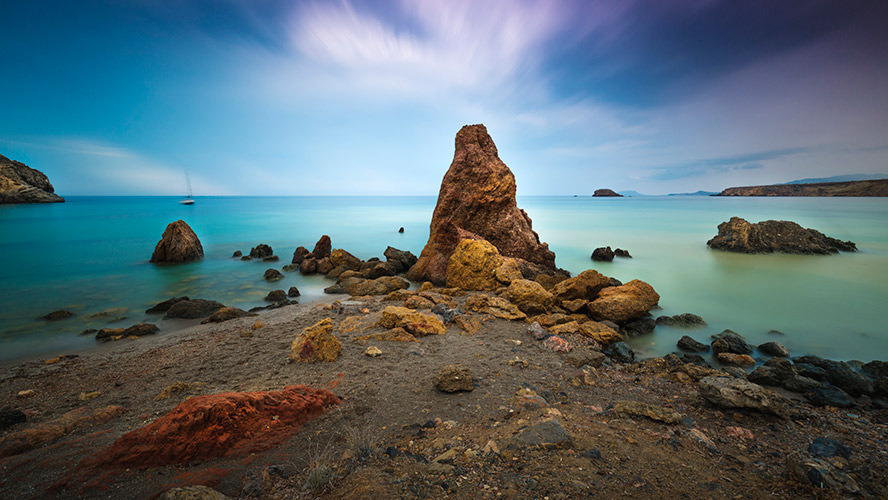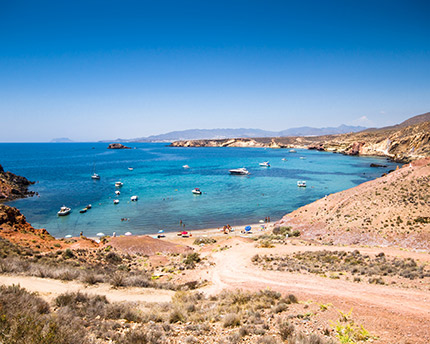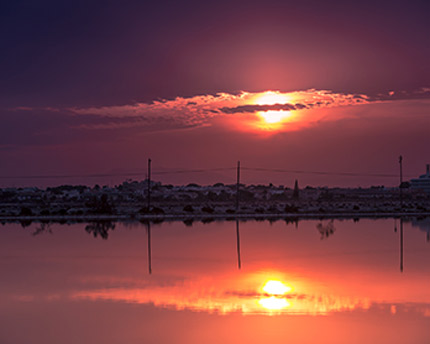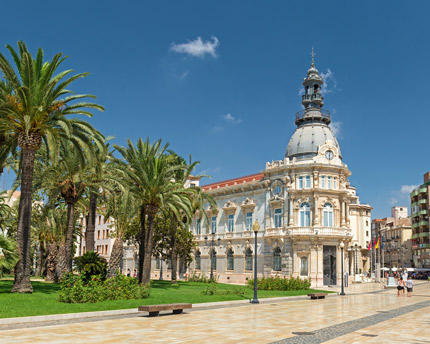Puerto de Mazarrón is the coastal centre of Mazarrón, one of the Region of Murcia’s main tourist towns. Both Mazarrón and Puerto de Mazarrón have several points of interest worth visiting, in addition to the many beaches that lie along this section of Murcia’s coastline.
Mazarrón has an impressive historical legacy, with several archaeological sites dating from the Palaeolithic Age up to the nineteenth-century mine workings — not forgetting the Copper Age, the Romans or the Phoenicians.
We’re going to look at some of the attractions that you won’t want to miss on any visit to Puerto de Mazarrón.
Villa del Alamillo Archaeological Site
One of the main points of interest for tourists in Puerto de Mazarrón is the Villa del Alamillo Archaeological Site. These ruins, located at the foot of the Alamillo beach, are the remains of a Roman villa dating from around the first century A.D.
Here we can see the foundations of the living area with rooms marked out around a courtyard, and the thermal baths, as well as the part of the villa where the inhabitants carried out their day-to-day tasks relating to farming and fishing. An important feature is several pits that would have been used for curing fish.

Balsa de El Alamillo
Still on the Villa de Alamillo site, but a few yards further north, are other important archaeological remains that formed the rest of Roman Mazarrón. This is known as the Balsa de Alamillo.
The Balsa was simply a rectangular water reservoir measuring 15 by 12 metres, with a capacity of over 250,000 litres. Its walls, which are still standing, were built of stone and lime, and had a drainage system involving aqueducts that provided water to the area’s villas, including the one at Alamillo. Some sections of the aqueduct system have been preserved.
Like the Villa del Alamillo, the water reservoir would date from the first century A.D.
The Acueducto del Arco
Not far from the Balsa, the Acueducto del Arco also survives. This is a system of channels built to bridge the uneven land — though much later, in around the eighteenth and nineteenth centuries. This hydraulic infrastructure, built using mortar and lime stonework as well as brick, brought water from the Alamillo spring to the farms in the area.
Use of the Acueducto del Arco ceased during the twentieth century when the spring ran dry.
The Phoenician Boat Interpretation Centre
Another people who left their mark on Mazarrón were the Phoenicians. Like many other parts of the Mediterranean, this area of the Iberian Peninsula was important for inland trade, and formed part of the trade routes used by the Phoenicians from the Near East.
Opposite the Island’s beach, you can still see the wreckage of two Phoenician boats dating from around the seventh century B.C. These are considered to be the two oldest Phoenician vessels found in the Mediterranean.
Whereas only a few elements (such as the keel and the timbers) remain of the vessel known as Mazarrón 1 discovered in 1988, Mazarrón 2 has survived in an excellent state of preservation, although a structure has been put in place to protect it while its future, in or out of the sea, is decided. The discovery of Mazarrón 2 in 1994 has provided valuable information about Phoenician boat building and the trade routes.
Fortunately, we can have a close look at these discoveries, and on dry land, at the Barco Fenicio Interpretation Centre, close to the Island’s beach. The Centre’s exhibits include a reproduction of a boat, information panels and audiovisual material on the history of the Phoenicians in Mazarrón.
The Bolnuevo Erosions
Las Gredas de Bolnuevo (or Erosiones de Bolnuevo) are one of the Region of Murcia’s most intriguing natural landscapes. The area is known as the “Enchanted City”, and is simply the result of the erosive action of the wind and the water over thousands of years, which has created these curious shapes.
“Greda” means sandy clay, and it is precisely this composition which has allowed these rocks to be worn down by the passage of the years, resulting in the loss of their weakest parts.
The Bolnuevo Erosions are located overlooking the seafront in the neighbouring town of Bolnuevo (to the west of Mazarrón) and were declared Assets of the Natural Heritage of the Region of Murcia in 2007. You can get close to the erosions and walk around them; if you do, use your imagination to find likenesses.
Where to eat in Mazarrón
A coastal town such as Mazarrón will inevitably have good establishments where you can try seafood and rice dishes, among other delicacies. Here are a few recommendations for places to eat in Mazarrón:
- Nueva Bodeguita: right on the quayside, it is a homage to the sea with dishes such as octopus, roast croaker, and sticky rice.
- Sal y Almagre: in the Alamillo area you will find this pleasant restaurant with sea views; we recommend dishes such as the tuna tartare and sturgeon confit.
- Fizz Gastro & Bar: another gastronomic highlight in Puerto de Mazarrón, with a menu featuring traditional dishes. Excellent cooking. This place also boasts an extensive wine list.
Where to stay in Murcia
Barely 50 minutes inland from Mazarrón is the city of Murcia itself, which can provide a superb base for a tour exploring this small but rich region in south-eastern Spain. If you decide to stay in the city of Murcia, we can recommend the Occidental Murcia Siete Coronas hotel, located in the heart of the city and just a few minutes’ walk from emblematic buildings such as the town hall and the Cathedral.
This four-star hotel has 156 rooms, a restaurant, gymnasium and, very important, a car park, so it is ideal for this Murcia road trip.













































































